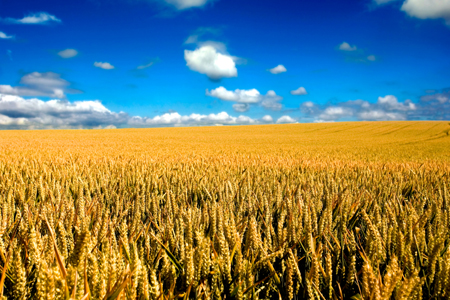 (Wall Street Journal) – Farmers Natalia and Yury Berezovsky have enjoyed two years of record wheat harvests. Now, they have one priority: Stay in business.
(Wall Street Journal) – Farmers Natalia and Yury Berezovsky have enjoyed two years of record wheat harvests. Now, they have one priority: Stay in business.
Ukraine has weathered war and tough times to deliver its biggest wheat harvests since the fall of the Soviet Union. But the country’s farmers are increasingly squeezed by a weakened currency and bank interest rates near 30%, making it tough to afford essential imports, such as fertilizer, seeds and new machinery.
The pressure is threatening to end a series of bumper harvests that made the country the world’s sixth-largest wheat producer this year—with potentially significant consequences for world markets.
“Our first priority is to stay afloat,” said Mr. Berezovsky, a 45-year-old farmer who used debt to expand his farm from 40 hectares (98.8 acres) in 1994 to 4,000 today. “We don’t have any thoughts to grow.”
Wheat is a crucial staple and politically sensitive export crop in markets around the world, and Ukraine is a major player.
Sunny weather and ample rain have helped the country produce its largest haul of wheat since 1990. Once billed as the breadbasket of Europe, Ukraine will export a record 15 million metric tons (a metric ton equals 2,204.62 pounds) in 2015, almost 4 million tons more than in 2014, according to estimates from the U.S. Agriculture Department’s Foreign Agricultural Service. That accounts for more than 9% of global wheat exports, and the surge has contributed to a more than 8% drop in Paris-traded wheat prices over the past three months.
Amid the glut, Ukraine’s weakened currency has made the country a tough competitor, along with Russia, against the world’s biggest producers: the European Union and the U.S.
“They are the cheapest on the market, they are winning most of the tenders, and this is really putting pressure on the global price,” said Stefan Vogel, head of the agriculture commodity research team at Rabobank.
This month, a ton of Black Sea wheat is selling for between $174 and $189, depending on the quality, according to the International Grains Council. French wheat sold for $190, and U.S. wheat sold for between $218 and $222. The spread between prices for Black Sea and U.S. wheat has tripled since May.
Since July, during harvest, Ukrainian wheat has won five of the 12 tenders held by the Egyptian state grain buyer, the world’s largest wheat importer.
U.S. producers, hampered by a strong dollar, have failed to win any.
“We haven’t had an Egypt tender within $20 in nine months,” said Scott O’Donnell, a Minneapolis-based grain broker at Frontier Futures. U.S. wheat is coming in fourth place on the world market, after Australia, he said.
According to a report from the Agriculture Department, Ukraine is gaining business even in traditional U.S. markets. In one sign of the dominance of Black Sea prices, Russian and Ukrainian wheat is now being imported into Mexico.
Despite the collapse in the Ukrainian economy, farming has boomed to this point, with 138 new farms this year, according to the country’s statistics service. The conflict has hit some of the most industrialized parts of Ukraine but has affected only a small portion of the agricultural land. Ukrainian wheat doesn’t depend on Russian markets, which have all but closed to other Ukrainian produce since Kiev’s fight with pro-Moscow separatists escalated following Russia’s annexation of Crimea last year.
But one of the factors that helped Ukrainian wheat sell cheaply, its battered currency, is now hurting farmers. The hryvnia has lost 40% of its its value against the dollar in the last 12 months. The USDA estimated that by June, fertilizers sold in Ukraine were around 15% more expensive this summer than the previous year.
Costs are rising broadly. The World Bank estimates the country’s core inflation rate will hit 50% this year. In response, Ukraine has kept its key interest rate high. It was lowered last month—to 22%—having spent six months parked at 30%.
For family farms that relied on relatively affordable credit in the past to expand, those sorts of interest costs are proving hard to bear. Recently, the Berezovskys turned down a loan of 2 million hryvnia ($94,400) at an interest rate of 27%, concerned that the debt-servicing cost would eat too deeply into their profits.
“Our whole lives we’ve bought credit and then paid it off,” said Ms. Berezovsky, who jokes about her husband buying a tractor before he bought a car.
This year’s bumper crop of seven metric tons of wheat per hectare is what is keeping the farm in the black, the couple said.
Even bigger farms with good credit histories are struggling. Agroprodservis, which employs 1,300 people and cultivates 40,000 hectares in western Ukraine, said it has struggled to get credit this year due to the cost. The company was being offered rates of 22% to 23% for loans with maturities of between one and five years.
“Our biggest tragedy is that there isn’t any money,” said Andrei Baran, director and co-owner of Agroprodservis.
That means that the farm has canceled plans to expand its pig-feeding complex and a soya storage facility.
Ukraine’s economy increasingly depends on agriculture. According to the World Bank, the sector’s share of gross domestic product grew from 7.9% in 2008 to 11.8% in 2014—about four times the global average.
“High interest rates on credit…truly create a significant problem for small and medium-sized producers,” Oleksiy Pavlenko, the country’s agriculture minister, said in an email.
Tighter credit could result in a cash shortages and bankruptcies at some farms by this spring, according to Mike Lee, an independent agronomist who specializes in the former Soviet Union. That, along with weakening yields due to cutbacks on fertilizers and acreage, could push up world wheat prices, Mr. Lee said.
“If Ukrainian agriculture catches a cold, the world takes notice,” he said.




